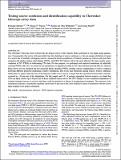Por favor, use este identificador para citar o enlazar a este item:
http://hdl.handle.net/10261/295888COMPARTIR / EXPORTAR:
 SHARE SHARE
 CORE
BASE CORE
BASE
|
|
| Visualizar otros formatos: MARC | Dublin Core | RDF | ORE | MODS | METS | DIDL | DATACITE | |

| Título: | Testing source confusion and identification capability in Cherenkov telescope array data |
Autor: | Mestre, Enrique CSIC ORCID; Torres, Diego F. CSIC ORCID; Oña Wilhelmi, Emma de CSIC ORCID; Martí, Josep | Palabras clave: | Instrumentation: detectors ISM: supernova remnants |
Fecha de publicación: | 2022 | Editor: | Oxford University Press | Citación: | Monthly Notices of the Royal Astronomical Society 517(3): 3550-3567 (2022) | Resumen: | The Cherenkov Telescope Array will provide the deepest survey of the Galactic Plane performed at very-high-energy gamma-rays. Consequently, this survey will unavoidably face the challenge of source confusion, i.e. the non-unique attribution of signal to a source due to multiple overlapping sources. Among the known populations of Galactic gamma-ray sources and given their extension and number, pulsar wind nebulae (PWNe, and PWN TeV haloes) will be the most affected. We aim to probe source confusion of TeV PWNe in forthcoming CTA data. For this purpose, we performed and analysed simulations of artificially confused PWNe with CTA. As a basis for our simulations, we applied our study to TeV data collected from the H.E.S.S. Galactic Plane Survey for ten extended and two point-like firmly identified PWNe, probing various configurations of source confusion involving different projected separations, relative orientations, flux levels, and extensions among sources. Source confusion, defined here to appear when the sum of the Gaussian width of two sources is larger than the separation between their centroids, occurred in ∼30 per cent of the simulations. For this sample and 0.5° of average separation between sources, we found that CTA can likely resolve up to 60 per cent of those confused sources above 500 GeV. Finally, we also considered simulations of isolated extended sources to see how well they could be matched to a library of morphological templates. The outcome of the simulations indicates a remarkable capability (more than 95 per cent of the cases studied) to match a simulation with the correct input template in its proper orientation. | Versión del editor: | https://doi.org/10.1093/mnras/stac2910 | URI: | http://hdl.handle.net/10261/295888 | DOI: | 10.1093/mnras/stac2910 | E-ISSN: | 1365-2966 |
| Aparece en las colecciones: | (ICE) Artículos |
Ficheros en este ítem:
| Fichero | Descripción | Tamaño | Formato | |
|---|---|---|---|---|
| testingdata.pdf | 8,26 MB | Adobe PDF |  Visualizar/Abrir |
CORE Recommender
SCOPUSTM
Citations
3
checked on 08-may-2024
WEB OF SCIENCETM
Citations
3
checked on 27-feb-2024
Page view(s)
19
checked on 07-may-2024
Download(s)
25
checked on 07-may-2024
Google ScholarTM
Check
Altmetric
Altmetric
Este item está licenciado bajo una Licencia Creative Commons

